WIRINGfor the information ageHOW TO WIRE ETHERNETPhoto © Judith Howcroft.By David Herresot long ago, wiring a residence or commercialfacility consisted of putting in theNright service and running branch circuitsfor lighting and other connected loads.At a certain point, telephone companiesstopped furnishing indoor equipment.That installation became the responsibilityof the owner, who could delegate it toonsite electricians or specialized telecom workers.In recent years, a large amount of other low-voltage workentered the mix, and non-power and light wiring constitute agood part of any new construction and renovation. There areplenty of cabling contractors well qualified to do this work,but since the traditional electrician is usually first onsite, lowvoltagework can be part of the overall electrical contract.An important focus in upscale residential and most commercialbuilding is the networking of computers and relatedequipment—notably Internet connectivity with multiplecomputers and printers. This type of setup is known as aLAN (local area network), and is generally confined to onebuilding (although a campus matrix is also common).The connectivity is usually accomplished through aningenious protocol known as ‘Ethernet’. This name evokesthe idea of universality, which is very appropriate consideringthat this important tool has been used worldwide formany years and shows no sign of being replaced by anycompeting technology.It’s not at all necessary for those wishing to wire Ethernetto understand the inner workings of this protocol, though alittle background is interesting and provides perspective onthe undertaking.What is Ethernet?At the heart of Ethernet is the acronym CSMA/CD, whichstands for Carrier Sense Multiple Access Collision Detect.This mouthful describes the Ethernet process. Each connectedentity in the network is continually ‘listening’ to determinewhether there’s data activity. When there’s no traffic, it is okayto transmit. In the event that two or more members of thenetwork begin transmitting at the same time, data streams willcollide and neither will be successful. Both halt transmission,then wait a random amount of time before retransmitting. Itis this protocol that makes Ethernet communication possible,though there are other elements to it, as well.There are two types of Ethernet elements: data terminalequipment (DTE) and data communication equipment(DCE). You can think of the former as providers and consumers,such as computers and printers, and the latter asfacilitators, such as hubs, switches and routers. Which of theseare being connected determines the wiring pin-out, whichwe’ll get into below.The other part of the equation is the Ethernet medium,most commonly unshielded twisted pair (UTP) or fiber optic(FO) cable. The original Ethernet ran on a serial coax busline, but this setup is considered obsolete.Traditional electrical work is serial in nature, colloquiallytermed ‘daisy chain’; branch circuit power comes from anovercurrent device in an entrance or sub panel, goes to thefirst device, such as a receptacle, then to the next, and so on.Photo of Cat 6 RJ45 connector © Bomar.TIA/EIA mandates RJ 45 pinouts for Ethernet connections.Looking at a connector with the clip to the back and wireopening down, there are eight terminals numbered 1-8starting at the left. For straight-through wiring, TIA 568-Bis used at both ends. For crossover wiring, T 568-A isused at one end and T 568-B at the other.TIA 568-ATerminal 1 – green/whiteTerminal 2 – greenTerminal 3 – orange/whiteTerminal 4 – blueTerminal 5 – blue/whiteTerminal 6 – orangeTerminal 7 – brown/whiteTerminal 8 – brown(Spiderwebbing—the practice of bringing power to a singlejunction box, then splicing out lines to the outlets—is consideredbad form.)In contrast, the preferred configuration for telephone andEthernet is star topology, where each branch is wired back tothe source. Although this configuration consumes more cable,it ensures there are no extra splices; splicing is undesirablebecause it disrupts the twisting of paired conductors, which iscrucial for counteracting inductive loss. Indeed, when terminatingUTP it is important that no more twists are eliminatedthan necessary.You can successfully wire Ethernet without knowing IEEE802.3. It is sufficient to understand that this protocol isPhoto of 60807 compression crimping tool © Greenlee.TIA 568-BTerminal 1 – orange/whiteTerminal 2 – orangeTerminal 3 – green/whiteTerminal 4 – blueTerminal 5 – blue/whiteTerminal 6 – greenTerminal 7 – brown/whiteTerminal 8 – brownAn unused RJ 45 connector is shown at top left. Bottom left isa cut-down connector used to straighten and prepare UTP endsbefore crimping. Top right is cable prior to this process. Bottomright is afterwards, ready to insert in new connector.contained within and implemented by Ethernet cards (NIC),which are required at both ends of any Ethernet link wherethey interface to the media (cabling). Ethernet cards are backwardcompatible, but there is a specialized version for fiberoptic cable, which terminates differently. (The mechanics ofoptical fiber are beyond the scope of this article. We’ll stickto copper cabling, which—in Cat 5e and later versions—iscapable of speeds and reliability appropriate to most networkscurrently being installed.)Installing category cablingThe first thing to consider is the type of cable to use and howit is to be installed. With regard to the installation method,raceway is not required for most environments. You can secureUTP to any wood finish surface but, for drywall, it is necessaryto use screw clips fastened through the plaster layer intostuds. Where a finish appearance is important, Wiremoldworks well. Where possible, it is best to conceal the cable usingfishtapes, chain, magnets and other electrician tools. In newconstruction, drill through studs and other framing prior toinsulation and wallboard. Do not place Ethernet wiring inthe same hole or close to power wiring.Though not required, premium results can be obtained byusing electrical metallic tubing (ETM) in commercial work.This versatile metal raceway is coupled and terminated witheasy setscrew fittings (or, for wet areas, compression fittings).A conduit bender creates gentle sweeps and EMT connectorsgo into box knockouts. Grounded metal raceway protectsagainst RF radiation, including harmonics, both incomingand outgoing. EMT provides fire protection as well, andanother advantage is that when the cabling becomes obsoletein the future, it can be used to pull optical fiber into place.However the installation is accomplished, it is essentialnot to damage the media (cable). UTP cable is fairly rugged,but any kinking, pinching or abrading can, at the very least,compromise connectivity (though the same fault would notdegrade a lower frequency telephone hookup). Also, don’t letanyone step on the cable as it is being run out of the carton.Do not use previously installed cable—save these pieces fortelephone circuits. Similarly, small wirenuts or crimpable bugsare suitable for telephone work but Ethernet circuits requiresplice-free runs.There are several UTP parameters to keep in mind:Solid versus stranded. UTP is available in both versions.Solid is used for a permanent installation whereas stranded isbetter for short patchcords that will be bent repeatedly. Solidhas better high-speed performance. It is important to use thecorrect connector type. Both are of the insulation displacementtype. The stranded variety pierces the conductors whereas thesolid version slides past and presses against them.Plenum, riser, general purpose, limited use. The currentcarried in an Ethernet circuit is incapable of igniting combustiblematerial, but insulation and jacketing material ignitedby fire originating elsewhere can contribute to flame propagationand produce significant amounts of thick toxic smoke.Hence it is important to choose the cable according to theenvironment in which it will be installed.14 • NOVEMBER/DECEMBER 2008 • www. mag.com
Photo © Judith Howcroft.The proper tools are necessary for Ethernet copper terminations. The cablestripper on the left is used to removes the jacket without nicking theconductors. At right is an RJ 45 crimper, which simultaneously connects all fourpairs and crimps around the jacket for strain relief. Top centre is a segment ofUTP Cat 5e cable with the jacket stripped and pairs untwisted. Bottom centre isan unused RJ 45 clip, required for UTP Ethernet connections.Photo of coax tool © Ideal Industries.A homemade jig is very helpful in preparing the end.Place an RJ 45 connector in a vise and trim off the backend. Insert a cable end into this device before terminating.It serves to straighten and align the conductorsso that they slide into place easier—without jammingor exchanging places. Notice that the cable jacket iscrimped inside the connector—this is the strain relief.Slide the rubber boot into place and you are done.As for the order of the conductors, there aretransmit and receive pins at both ends. You have toconnect the transmit pins at one end to the receivepins at the other end. Sometimes you use straightthroughwiring, the terminations being thesame at both ends. In other situations youemploy crossover wiring. It depends on what isconnected at each end. When you are going froman Ethernet hub or switch to a computer, usestraight-through wiring. When you’re goingfrom a computer to another computer, orfrom a hub to another hub, use the crossoverconfiguration. When you make a crossover cable,mark both terminations with an X so that therewill be no confusion in the future.Ready to wire for the information ageDespite the finickiness of communications cabling,one does not require years of study to get into Ethernetwiring. Take some time to practice with thecabling, connectors and related tools... maybe evenwire your own house for connectivity. Get advicefrom your suppliers. Then, when you feel morecomfortable with the process, add it to your serviceoffering. After all, if you’re already there for all theelectrical work, why not add to your bottom line bydoing the low-voltage installation as well?Plenum is used within any cavity that also servesto transport air from one part of the building toanother. Riser is used for vertical runs penetratingmore than one floor. General purpose is for otherlocations and limited use is for dwellings only.Plenum, the most costly of the three, can be substitutedfor riser and general purpose. Riser cansubstituted for general purpose. Any of these canbe substituted for limited use cable. For small jobs,you may find it easier to keep a single carton ofplenum cable on hand and use it for everything.The Firstname in wirecable trayUTP cable is further divided into indoor and wetlocation (which can be used outdoors or underground,usually in rigid non-metallic conduit).Underground installations should come out ofthe ground at buildings through 90° sweeps, andexpansion joints used where subject to frost action,with LBs stubbed into the building through a holein the siding and rim joist.TerminationsFinally we come to the subject of terminations.The cable should be run first with plenty ofextra wire at each end. Trim off any damagedends. Depending on the version, Ethernet protocolcalls for either two or four pairs to be usedbut, in both cases, the wiring is done the sameway (i.e. unused pairs are also terminated, formechanical strength).First slide on a rubber boot. This optional itemimproves the quality of the job by protecting thecable where it enters the connector and preventingthe entry of moisture or dust. Trim the jacket backabout 2 in. or 3 in. It is best to use a bona fidedata cable stripper for this work, but an electrician’swire stripper 10 AWG cutter will work if notclosed completely. Take care not to nick the insulationof the twisted pair, which could compromisehigh-speed performance. With sharp scissors, cutoff the rip cord. Untwist the pairs back to thejacket, fan them out in a flat plane and arrangethem in the proper order.Straighten them out and make them parallel andat the right intervals to go into the RJ 45 connector.Then, again using sharp scissors or the cutterbuilt into some crimpers, make the final cut acrossall eight conductors. The untwisted conductorsshould be no longer than 1/2 in. Otherwise, thenetwork will become prone to crosstalk (the phenomenonby which a signal transmitted on onecircuit/channel of a transmission system creates anundesired effect in another). Straighten the conductorsand push them firmly into the connector,making sure they all bottom out, none of thembuckle or fold over, and none of them exchangeplaces. Crimp them with a good squeeze. It is necessaryto use the proper crimper, as a pair of plierssimply will not work.Over 35 years ago, Cablofil invented the concept of wire cabletray. Since then Cablofil/Legrand ® has become the world leaderin cable management with more than 90,000 miles of trayinstalled globally. Cablofil tray features our unique Safe-T-Edgethat protects cables and installers from sharp wire ends. Andenhance your installation productivity with Cablofil accessoriesfeaturing our patented Fast Assembling System (FAS) for cabletray support and our EDRN Fast Splices. Look to the industryleader, Cablofil/Legrand, for the most innovative cablemanagement solutions.THE WORLD’S MOST SPECIFIED CABLE TRAY.www.cablofil.com800-658-46418319 State Route 4Mascoutah, IL 62258 USACablofil_EB_Nov08.indd 110/14/08 10:26:58 AMwww. mag.com • NOVEMBER/DECEMBER 2008 • 15
















